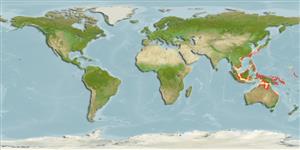Environment: milieu / climate zone / depth range / distribution range
Ecología
marino; salobre demersal. Tropical
Western Pacific: South and southeast Asia, southern New Guinea and northern Australia.
Tamaño / Peso / Age
Maturity: Lm ? range ? - ? cm
Max length : 47.0 cm TL macho / no sexado; (Ref. 7050)
Life cycle and mating behavior
Maturities | Reproducción | Spawnings | Egg(s) | Fecundities | Larva
Marceniuk, A.P. and N.A. Menezes, 2007. Systematics of the family Ariidae (Ostariophysi, Siluriformes), with a redefinition of the genera. Zootaxa 1416:1-126. (Ref. 58022)
IUCN Red List Status (Ref. 130435)
Threat to humans
Traumatogenic (Ref. 58010)
Human uses
Herramientas
Special reports
Download XML
Fuentes de Internet
Estimates based on models
Preferred temperature (Ref.
123201): 24.7 - 29.1, mean 28.3 °C (based on 832 cells).
Phylogenetic diversity index (Ref.
82804): PD
50 = 0.5039 [Uniqueness, from 0.5 = low to 2.0 = high].
Bayesian length-weight: a=0.00813 (0.00384 - 0.01719), b=3.06 (2.88 - 3.24), in cm total length, based on LWR estimates for this (Sub)family-body shape (Ref.
93245).
Nivel trófico (Ref.
69278): 3.7 ±0.3 se; based on size and trophs of closest relatives
Resiliencia (Ref.
120179): Medio, población duplicada en un tiempo mínimo de 1.4-4.4 años (Preliminary K or Fecundity.).
Fishing Vulnerability (Ref.
59153): Moderate vulnerability (37 of 100).
